Ioannis Kakogeorgiou
Attention, Please! Revisiting Attentive Probing for Masked Image Modeling
Jun 11, 2025Abstract:As fine-tuning (FT) becomes increasingly impractical at scale, probing is emerging as the preferred evaluation protocol for self-supervised learning (SSL). Yet, the standard linear probing (LP) fails to adequately reflect the potential of models trained with Masked Image Modeling (MIM), due to the distributed nature of patch tokens. This motivates the need for attentive probing, an alternative that uses attention to selectively aggregate patch-level features. Despite its growing adoption, attentive probing remains under-explored, with existing methods suffering from excessive parameterization and poor computational efficiency. In this work, we revisit attentive probing through the lens of the accuracy-efficiency trade-off. We conduct a systematic study of existing methods, analyzing their mechanisms and benchmarking their performance. We introduce efficient probing (EP), a multi-query cross-attention mechanism that eliminates redundant projections, reduces the number of trainable parameters, and achieves up to a 10$\times$ speed-up over conventional multi-head attention. Despite its simplicity, EP outperforms LP and prior attentive probing approaches across seven benchmarks, generalizes well beyond MIM to diverse pre-training paradigms, produces interpretable attention maps, and achieves strong gains in low-shot and layer-wise settings. Code available at https://github.com/billpsomas/efficient-probing.
Boosting Generative Image Modeling via Joint Image-Feature Synthesis
Apr 22, 2025Abstract:Latent diffusion models (LDMs) dominate high-quality image generation, yet integrating representation learning with generative modeling remains a challenge. We introduce a novel generative image modeling framework that seamlessly bridges this gap by leveraging a diffusion model to jointly model low-level image latents (from a variational autoencoder) and high-level semantic features (from a pretrained self-supervised encoder like DINO). Our latent-semantic diffusion approach learns to generate coherent image-feature pairs from pure noise, significantly enhancing both generative quality and training efficiency, all while requiring only minimal modifications to standard Diffusion Transformer architectures. By eliminating the need for complex distillation objectives, our unified design simplifies training and unlocks a powerful new inference strategy: Representation Guidance, which leverages learned semantics to steer and refine image generation. Evaluated in both conditional and unconditional settings, our method delivers substantial improvements in image quality and training convergence speed, establishing a new direction for representation-aware generative modeling.
EQ-VAE: Equivariance Regularized Latent Space for Improved Generative Image Modeling
Feb 13, 2025



Abstract:Latent generative models have emerged as a leading approach for high-quality image synthesis. These models rely on an autoencoder to compress images into a latent space, followed by a generative model to learn the latent distribution. We identify that existing autoencoders lack equivariance to semantic-preserving transformations like scaling and rotation, resulting in complex latent spaces that hinder generative performance. To address this, we propose EQ-VAE, a simple regularization approach that enforces equivariance in the latent space, reducing its complexity without degrading reconstruction quality. By finetuning pre-trained autoencoders with EQ-VAE, we enhance the performance of several state-of-the-art generative models, including DiT, SiT, REPA and MaskGIT, achieving a 7 speedup on DiT-XL/2 with only five epochs of SD-VAE fine-tuning. EQ-VAE is compatible with both continuous and discrete autoencoders, thus offering a versatile enhancement for a wide range of latent generative models. Project page and code: https://eq-vae.github.io/.
Advancing Semantic Future Prediction through Multimodal Visual Sequence Transformers
Jan 14, 2025



Abstract:Semantic future prediction is important for autonomous systems navigating dynamic environments. This paper introduces FUTURIST, a method for multimodal future semantic prediction that uses a unified and efficient visual sequence transformer architecture. Our approach incorporates a multimodal masked visual modeling objective and a novel masking mechanism designed for multimodal training. This allows the model to effectively integrate visible information from various modalities, improving prediction accuracy. Additionally, we propose a VAE-free hierarchical tokenization process, which reduces computational complexity, streamlines the training pipeline, and enables end-to-end training with high-resolution, multimodal inputs. We validate FUTURIST on the Cityscapes dataset, demonstrating state-of-the-art performance in future semantic segmentation for both short- and mid-term forecasting. We provide the implementation code at https://github.com/Sta8is/FUTURIST .
DINO-Foresight Looking into the Future with DINO
Dec 16, 2024



Abstract:Predicting future dynamics is crucial for applications like autonomous driving and robotics, where understanding the environment is key. Existing pixel-level methods are computationally expensive and often focus on irrelevant details. To address these challenges, we introduce $\texttt{DINO-Foresight}$, a novel framework that operates in the semantic feature space of pretrained Vision Foundation Models (VFMs). Our approach trains a masked feature transformer in a self-supervised manner to predict the evolution of VFM features over time. By forecasting these features, we can apply off-the-shelf, task-specific heads for various scene understanding tasks. In this framework, VFM features are treated as a latent space, to which different heads attach to perform specific tasks for future-frame analysis. Extensive experiments show that our framework outperforms existing methods, demonstrating its robustness and scalability. Additionally, we highlight how intermediate transformer representations in $\texttt{DINO-Foresight}$ improve downstream task performance, offering a promising path for the self-supervised enhancement of VFM features. We provide the implementation code at https://github.com/Sta8is/DINO-Foresight .
Composed Image Retrieval for Remote Sensing
May 29, 2024


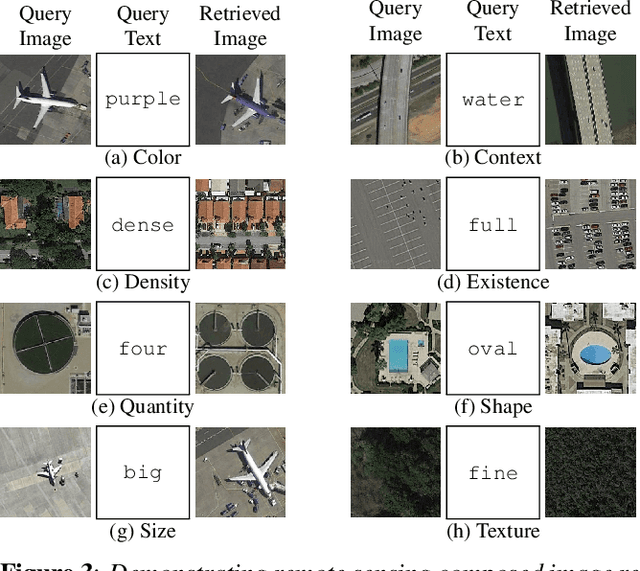
Abstract:This work introduces composed image retrieval to remote sensing. It allows to query a large image archive by image examples alternated by a textual description, enriching the descriptive power over unimodal queries, either visual or textual. Various attributes can be modified by the textual part, such as shape, color, or context. A novel method fusing image-to-image and text-to-image similarity is introduced. We demonstrate that a vision-language model possesses sufficient descriptive power and no further learning step or training data are necessary. We present a new evaluation benchmark focused on color, context, density, existence, quantity, and shape modifications. Our work not only sets the state-of-the-art for this task, but also serves as a foundational step in addressing a gap in the field of remote sensing image retrieval. Code at: https://github.com/billpsomas/rscir
SPOT: Self-Training with Patch-Order Permutation for Object-Centric Learning with Autoregressive Transformers
Dec 01, 2023



Abstract:Unsupervised object-centric learning aims to decompose scenes into interpretable object entities, termed slots. Slot-based auto-encoders stand out as a prominent method for this task. Within them, crucial aspects include guiding the encoder to generate object-specific slots and ensuring the decoder utilizes them during reconstruction. This work introduces two novel techniques, (i) an attention-based self-training approach, which distills superior slot-based attention masks from the decoder to the encoder, enhancing object segmentation, and (ii) an innovative patch-order permutation strategy for autoregressive transformers that strengthens the role of slot vectors in reconstruction. The effectiveness of these strategies is showcased experimentally. The combined approach significantly surpasses prior slot-based autoencoder methods in unsupervised object segmentation, especially with complex real-world images. We provide the implementation code at https://github.com/gkakogeorgiou/spot .
Keep It SimPool: Who Said Supervised Transformers Suffer from Attention Deficit?
Sep 13, 2023
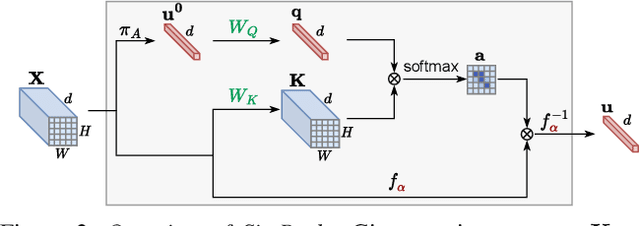
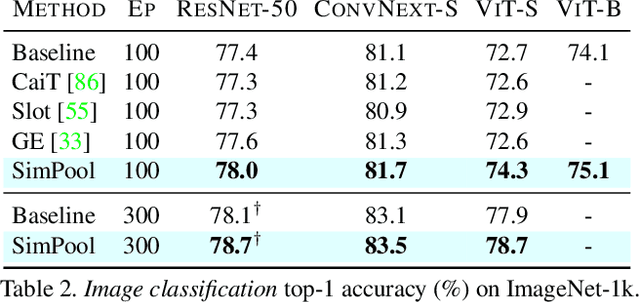
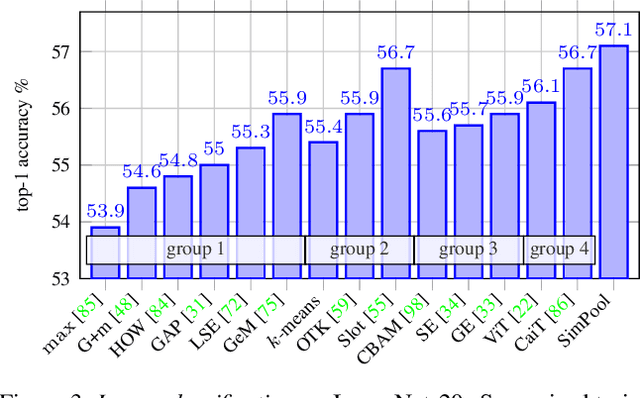
Abstract:Convolutional networks and vision transformers have different forms of pairwise interactions, pooling across layers and pooling at the end of the network. Does the latter really need to be different? As a by-product of pooling, vision transformers provide spatial attention for free, but this is most often of low quality unless self-supervised, which is not well studied. Is supervision really the problem? In this work, we develop a generic pooling framework and then we formulate a number of existing methods as instantiations. By discussing the properties of each group of methods, we derive SimPool, a simple attention-based pooling mechanism as a replacement of the default one for both convolutional and transformer encoders. We find that, whether supervised or self-supervised, this improves performance on pre-training and downstream tasks and provides attention maps delineating object boundaries in all cases. One could thus call SimPool universal. To our knowledge, we are the first to obtain attention maps in supervised transformers of at least as good quality as self-supervised, without explicit losses or modifying the architecture. Code at: https://github.com/billpsomas/simpool.
* ICCV 2023. Code and models: https://github.com/billpsomas/simpool
What to Hide from Your Students: Attention-Guided Masked Image Modeling
Mar 23, 2022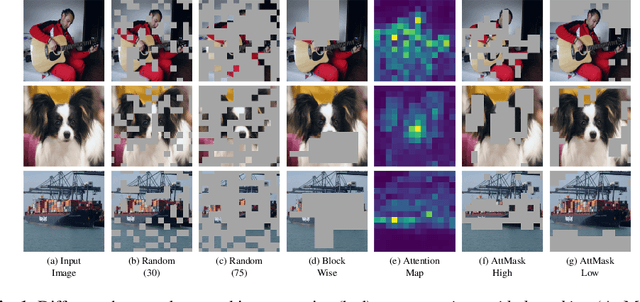
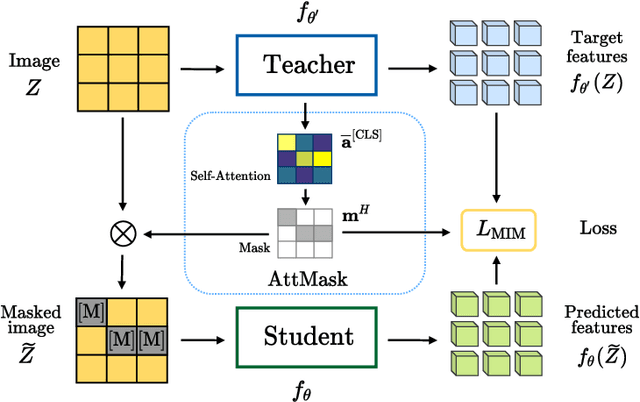
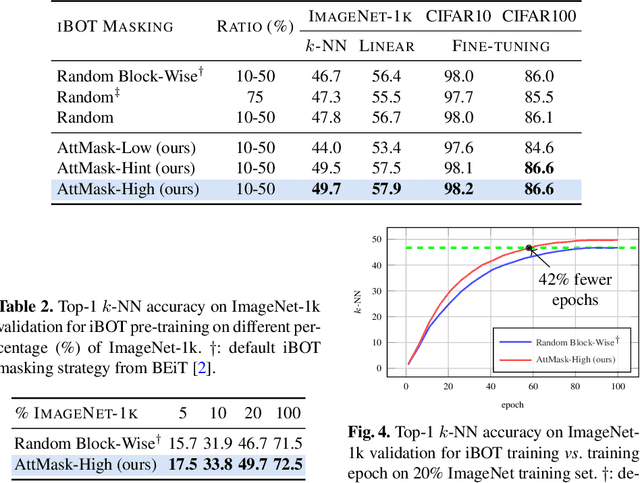

Abstract:Transformers and masked language modeling are quickly being adopted and explored in computer vision as vision transformers and masked image modeling (MIM). In this work, we argue that image token masking is fundamentally different from token masking in text, due to the amount and correlation of tokens in an image. In particular, to generate a challenging pretext task for MIM, we advocate a shift from random masking to informed masking. We develop and exhibit this idea in the context of distillation-based MIM, where a teacher transformer encoder generates an attention map, which we use to guide masking for the student encoder. We thus introduce a novel masking strategy, called attention-guided masking (AttMask), and we demonstrate its effectiveness over random masking for dense distillation-based MIM as well as plain distillation-based self-supervised learning on classification tokens. We confirm that AttMask accelerates the learning process and improves the performance on a variety of downstream tasks.
Evaluating Explainable Artificial Intelligence Methods for Multi-label Deep Learning Classification Tasks in Remote Sensing
Apr 03, 2021
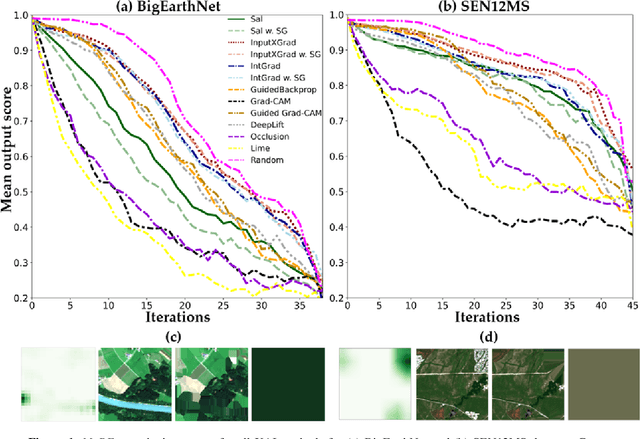


Abstract:Although deep neural networks hold the state-of-the-art in several remote sensing tasks, their black-box operation hinders the understanding of their decisions, concealing any bias and other shortcomings in datasets and model performance. To this end, we have applied explainable artificial intelligence (XAI) methods in remote sensing multi-label classification tasks towards producing human-interpretable explanations and improve transparency. In particular, we developed deep learning models with state-of-the-art performance in the benchmark BigEarthNet and SEN12MS datasets. Ten XAI methods were employed towards understanding and interpreting models' predictions, along with quantitative metrics to assess and compare their performance. Numerous experiments were performed to assess the overall performance of XAI methods for straightforward prediction cases, competing multiple labels, as well as misclassification cases. According to our findings, Occlusion, Grad-CAM and Lime were the most interpretable and reliable XAI methods. However, none delivers high-resolution outputs, while apart from Grad-CAM, both Lime and Occlusion are computationally expensive. We also highlight different aspects of XAI performance and elaborate with insights on black-box decisions in order to improve transparency, understand their behavior and reveal, as well, datasets' particularities.
 Add to Chrome
Add to Chrome Add to Firefox
Add to Firefox Add to Edge
Add to Edge